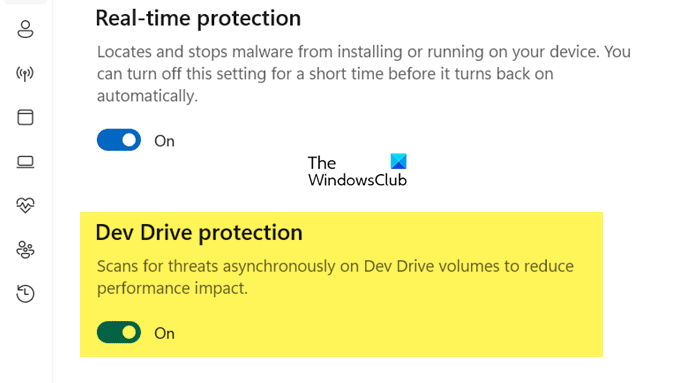Microsoft has introduced a new type of storage volume that improves Windows performance. It was developed on Resilient File System or ReFS technology. ReFS was built to overcome the limitations faced by NTFS or the New Technology File System. In this post, we will learn how to enable or disable Dev Drive Protection in Windows 11.
How to Enable or Disable Dev Drive Protection in Windows 11
Dev Drive Protection was created to protect the Dev Drive. With this, the newly added drive will have antivirus support. There are two performance modes of Dev Drive. If the Performance Mode State is disabled, the scan will be synchronous, which is real-time, so, when you open a file, Real-time protection will be triggered. Whereas, if the Performance Mode Start is enabled, the scan will be asynchronous, and the scan will not be initiated as soon as the file opens.
This Dev Drive Protection feature is currently available in Windows 11 Build 25931 and will be rolled out to the stable versions soon.
So, check for updates and install the ones available. Once you have updated your operating system, let us see how to enable or disable Dev Drive Protection in Windows 11 using Windows Security or Registry Editor,
1] Turn On or Off Dev Drive Protection using Windows Security

Let us first see how to configure Dev Drive Protection easily using the Windows Security app.
Open Windows Security and follow the steps below to enable Dev Drive Protection.
- Click on Virus & threat protection from the left panel of the window.
- Now, from the Virus & threat protection settings, click on the Manage Settings.
- Next up, look for Dev Drive protection and then enable it.
- In case, Dev Drive protection is greyed out, you need to enable Real-time protection; otherwise, it won’t work.
- Finally, click on the Exit button.
This will enable Dev Drive Protection. If you want to disable it, you must untick the Dev Drive protection option. You don’t necessarily have to disable it, as that would make your Dev Drive susceptible to viruses and malware.
Read: How to disable or enable ReFS or Resilient File System on Windows
2] Enable or Disable Dev Drive protection using Registry Editor
We can also configure Dev Drive Protection from the Registry Editor. However, before making any changes to the Registry Editor, we must create its backup. The backup can be used if something goes wrong.
Open Run by Win + R, type “regedit” and click OK.
Now, navigate to the following location.
HKEY_LOCAL_MACHINE\SOFTWARE\Microsoft\Windows Defender\Real-Time Protection
In case, there is no Real-Time Protection, right-click on the Windows Defender folder and select New > Key, and name the newly created folder, Real-Time Protection.
Now, right-click on Real-Time Protection, select New > DWORD (32-bit) Value, and name it DisableAsyncScanOnOpen.
Then, double-click on DisableAsyncScanOnOpen and set its value to 0 to enable Dev Drive protection and 1 to disable it.
Finally, close Registry Editor and then reboot your system.
That’s it!
Next, we will see how to set Dev Drive as Trusted or Untrusted in Windows 11
How do I enable Dev Drive in Windows 11?

If you want to enable Dev Drive in Windows 11, search out “Windows Settings” from the Start Menu. Now, navigate to System > Storage > Advanced Storage > Disks & volumes, and finally, select Create dev drive. To know more, check our guide to configure Dev Drive.
Read: How to disable or enable Developer Mode in Windows 11?
How do I turn off Windows 11 protection?
You can easily disable Windows 11 antivirus from the Windows Security app. Just go to Start and search for Windows Security. Now, go to Virus & threat protection > Manage settings. Finally, you have to disable to toggle of Real-time protection.
Also Read: Fix REFS_FILE_SYSTEM Blue Screen error.
Leave a Reply